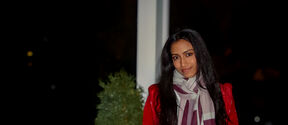What do we see in a mirror? New metasurfaces look “bright” at one direction, while “dark” for the opposite direction

When we look at a mirror from an angle, we see the image of the object located at the opposite direction. This is because the scattering light of the object is reflected by the mirror and then perceived by observers’ eyes. This process, known as specular reflection, is angle-symmetric: if the person stands on the left side of mirror can see the right person, then the right person can always see the left one with the same clearness. Conventional mirrors always have symmetric responses for light coming from both sides of the mirrors. Recently, researchers at Aalto University have successfully broken the angle-symmetric response of a mirror using the concept of gradient metasurfaces. The artificially synthesized surfaces can be designed to look “bright” at one direction, while “dark” for the observer at the opposite direction.
Metasurfaces are planar artificial materials, composed of periodic arranged meta-atoms at subwavelength scale. Meta-atoms are made of traditional materials but, if they are placed in a repeating patterns, the array can show many unusual effects which cannot be realized by the natural materials.. In their article Extreme Asymmetry in Metasurfaces via Evanescent Fields Engineering: Angular-Asymmetric Absorption published in Physical Review Letters, the team from Aalto use gradient metasurfaces to engineer the contrast ratio of brightness for waves coming from two oppositely tilted angles.
“Our findings provide the first demonstration that a flat surface can realize extreme optical asymmetry in angle spectrum. This is an important milestone in both physics and engineering communities,” says Xuchen Wang, who is currently a third-year doctoral student in Aalto University, and also the responsible person of this work. Xuchen studies electromagnetic metasurfaces under the supervision of Prof. Sergei Tretyakov.
The article was published in the online version of the journal on 19 December 2018. The study has received funding from the Academy of Finland.
For further information please contatct Xuchen Wang
Email: Xuchen.wang@aalto.fi
Phone: +358-503097794
Institution: Department of Electronics and Nanoengineering, Aalto University
Address: Maarintie 8, 02150 Espoo, Finland
Read more news

Aalto Inventors innovation training coming for hydrogen, quantum and microelectronics researchers this spring
Connect with industry and academic thought-leaders and gain widely applicable skills in communication, intellectual property, and business.
Start the year with new insights – apply for FITech's spring courses!
Deepen your knowledge with courses from Finnish universities of technology, designed to meet the demands of the working life and help deepen your expertise for free.
Combining studies in technology and business allows Kriti Bojja to navigate multiple career directions
Kriti Bojja is excited about the variety of career opportunities the Digital Systems and Design major will allow her to pursue






